Another 5-year IPCC literature assessment cycle is slowly drawing to a close. Having lost two of four in-person meetings to COVID-19, globally working strange hours for almost 3 years, and with the authors and delegates working twice as long as expected to get approval, the Working Group III “Mitigation of Climate Change” portion of the Sixth IPCC Assessment has been approved. There is bad news, good news, and a lot for the climate community to work with.
The worst news is that GHG emissions of almost all kinds are still going up, pushing 1.5°C further and further from reach–COVID did not trigger the hoped-for systemic change in GHG intense energy use, e.g. from telework. The existing nationally determined contributions (NDCs), before and after announcements at COP26 in Glasgow, will lead to exceeding the 1.5°C and probably even the 2°C targets. While renewables are very popular in most regions, the needed phase-out of fossil fuels is extremely contentious, and there is significant global disagreement on bioenergy, fossil fuels with carbon capture and storage (CCS) and nuclear of all kinds. Finally, tracked financial flows fall well short of levels needed to achieve mitigation goals.
There is also, however, lots of material for optimism. There is now a dramatically higher level of seriousness on climate policy since COP21 and the Paris Agreement in 2015. The costs of many key energy supply and demand technologies have fallen dramatically while their effectiveness has improved, e.g. wind, solar PV, concentrating solar power, mobile and stationary batteries, and heat pumps, leading to exponential growth in their use. There is also new emphasis in all sectors on demand side and material GHG efficiency options to supplement energy efficiency, fuel switching and carbon management. All sectors have the technological and behavioural means to make significant progress right away, and to go to net-zero CO2 by the early 2050s. Mitigation policy, be it regulations or pricing at the equivalent of $100/t USD or less, could eliminate half of 2019 global emissions by 2030. There are also tremendous local air quality health and indeed energy security co-benefits from elimination of fossil fuel combustion near people.
Sustainable development is not possible without accelerated climate change mitigation. Sustainable development pathways require an all stakeholder, multi-jurisdictional level approach to climate policy. Enabling conditions include finance, technological innovation, strengthening policy instruments, institutional capacity, multi-level governance and changes in human behaviour and lifestyles.
Given the pace of mitigation, some level of natural and technological carbon dioxide removal (CDR) is likely unavoidable, but there are substantial permanence, cost and institutional risks.
Overall, however, both the technical and political feasibility of mitigation is the highest it has ever been. The question is how fast it can occur, and what damages we will collectively sustain in the meantime.


